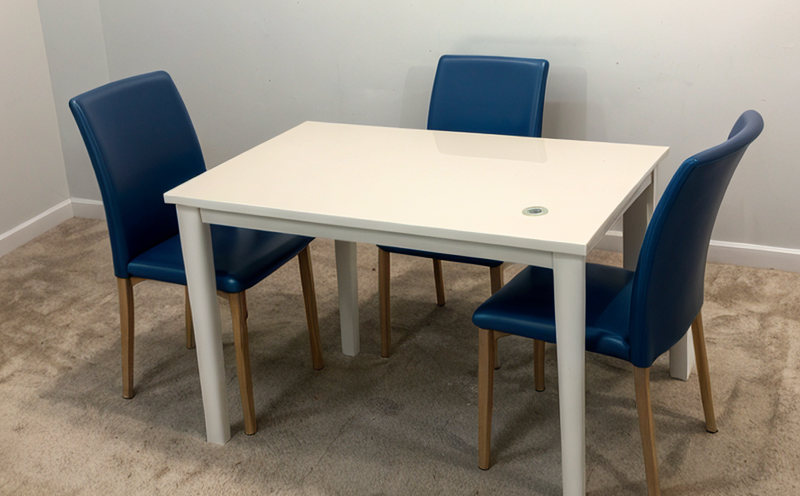IEC 62631 Dielectric Properties Testing of Furniture Plastics
The International Electrotechnical Commission (IEC) standard IEC 62631 specifies the methods for determining dielectric properties, which are critical in assessing the electrical insulation performance of materials used in furniture and interior plastics. This testing is crucial for ensuring product safety, compliance with regulations, and meeting market demands.
The dielectric properties of a material determine its ability to store and conduct electric energy. For furniture plastics, understanding these properties helps manufacturers identify potential risks associated with electrical shock hazards and ensure that the materials used are suitable for use in environments where electrical components may be present. This is particularly important as the industry continues to innovate with new materials and designs.
The testing process involves several steps, including specimen preparation, measurement, and analysis. Specimens must be prepared according to IEC 62631 specifications to ensure accurate results. The dielectric constant (permittivity) and loss factor (tan δ), which are key parameters in this test, provide insights into the material's ability to store electric energy and dissipate it as heat.
Understanding these properties is essential for ensuring that furniture and interior plastics meet safety standards such as IEC 62631. The testing process can be complex, requiring precise control of environmental factors like temperature and humidity. Advanced instrumentation, such as capacitance bridges or network analyzers, are typically used to perform the measurements accurately.
The results of this test provide critical data that helps manufacturers make informed decisions about material selection and design. By ensuring compliance with IEC 62631, companies can enhance product safety, reduce liability risks, and maintain a competitive edge in the market.
Why It Matters
The importance of dielectric properties testing cannot be overstated, particularly for furniture manufacturers who are increasingly incorporating plastics into their products. Compliance with standards like IEC 62631 is essential to ensure that the materials used do not pose electrical hazards or fail under specified conditions.
Dielectric properties play a significant role in determining how well a material can insulate against electrical currents. In furniture and interior applications, this is particularly important for ensuring safety when electrical components are present. The test results from IEC 62631 help manufacturers identify potential risks associated with electrical shock hazards and ensure that the materials used are suitable for use in environments where electricity is a concern.
By understanding these properties, companies can design products that meet both regulatory requirements and market expectations. This not only enhances product safety but also helps to build brand reputation and consumer trust. In an era of increasing demand for safer, more reliable products, dielectric testing becomes a key differentiator in the competitive landscape.
The results of this test are particularly valuable in industries where electrical components may come into contact with furniture or interior plastics. By ensuring compliance with IEC 62631, companies can enhance product safety and reduce liability risks. This is especially important given the growing number of accidents related to electrical shock hazards.
Environmental and Sustainability Contributions
The use of plastics in furniture and interior design has grown significantly over recent years, driven by advancements in material science and consumer preferences. However, with this growth comes a need for increased focus on environmental sustainability. Dielectric properties testing plays an important role in this context by ensuring that the materials used are not only safe but also sustainable.
By understanding the dielectric properties of plastics, manufacturers can make informed decisions about material selection and design, which helps to minimize waste and reduce the environmental impact of their products. This is particularly relevant for furniture and interior designers who are increasingly incorporating recycled or bio-based materials into their designs.
The test results from IEC 62631 also help companies comply with regulatory requirements related to sustainability. For example, some countries have regulations in place that mandate the use of environmentally friendly materials in certain applications. By ensuring compliance with these standards, manufacturers can reduce their carbon footprint and contribute to a more sustainable future.
In addition to enhancing product safety and reducing environmental impact, dielectric properties testing also helps companies meet market demands for safer, more reliable products. This is particularly important given the growing number of accidents related to electrical shock hazards. By ensuring compliance with IEC 62631, companies can enhance consumer trust in their products and build a strong brand reputation.
Competitive Advantage and Market Impact
Compliance with international standards enhances product safety and reduces liability risks.
Meeting market demands for safer, more reliable products improves consumer trust and brand reputation.
Understanding dielectric properties allows manufacturers to design products that meet both regulatory requirements and market expectations.
The test results provide critical data that helps companies make informed decisions about material selection and design.
By ensuring compliance with IEC 62631, companies can enhance product safety and reduce environmental impact.
The results of this test are particularly valuable in industries where electrical components may come into contact with furniture or interior plastics.
Ensuring compliance with international standards such as IEC 62631 is essential for manufacturers who want to stay ahead of the competition. By meeting these standards, companies can differentiate themselves from their rivals and gain a competitive edge in the market. This is particularly important given the growing demand for safer, more reliable products.
In an era where safety and sustainability are top priorities, dielectric properties testing becomes a key differentiator in the competitive landscape. By ensuring compliance with IEC 62631, companies can enhance product safety, reduce environmental impact, and build strong brand reputation. This is especially important given the growing number of accidents related to electrical shock hazards.





